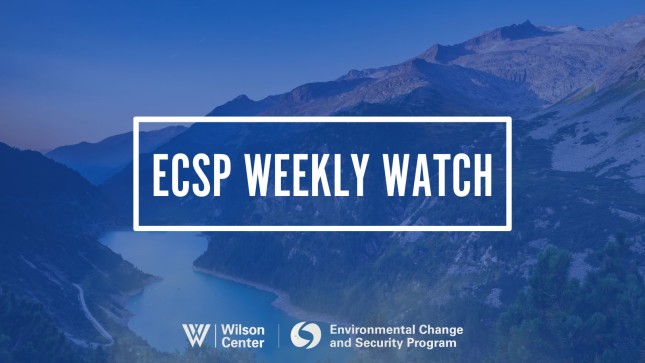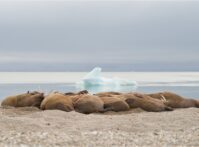-
ECSP Weekly Watch: March 25 – 29
March 29, 2024 By Eleanor Greenbaum
A window into what we are reading at the Wilson Center’s Environmental Change and Security Program
UN Report Highlights Relationship Between Water and Peace (UN Water)
Freshwater consumption is growing at a steady rate, driven largely by agriculture, yet roughly 50% of the world’s population experiences severe water scarcity for at least part of the year. Poor water quality in low-income countries is attributable to low wastewater treatment, whereas in high-income countries, agricultural runoff does the damage. Extreme droughts or heavy rainfall, exacerbated by climate change, also have worsened in frequency and intensity, creating a deepening impact on global water security.
In this context, the UN World Water Development Report 2024 focuses on water as a tool for prosperity and peace, due in large part to the resource’s interconnectedness with indicators of stability. While cooperation over water resources has generated positive and peaceful outcomes, inequalities in water allocation—exacerbated by climate change—undermine global peace and security goals. While there is no direct metric to link water availability and prosperity, 70-80% of jobs in low- and middle-income countries rely upon water, and global investments in WaSH have a proven benefit for local communities and larger societies.
The new report adopts thematic perspectives of agriculture, human settlements, industry, energy, environment, and transboundary cooperation, and places them alongside regional views of the question, to more effectively address water stress on a localized level. Its recommendations include collective and equitable water governance that promotes information and benefit-sharing; applying science, technology, and innovation to water management; improving education and capacity development; and mobilizing financing and investments.
READ | The Global Challenge of Water’s Weaponization in War: Lessons from Yemen, Ukraine, and Libya
Extreme Heat Emerges as a Major Global Threat (Al Jazeera)
Extreme heat poses an increasing challenge for the global community, as demonstrated by 2023 registering as the hottest global year on record by a large margin. South Sudan now faces heats of 108 degrees Fahrenheit, and only last week, Brazil faced temperatures of up to 144 degrees Fahrenheit. Heatwaves killed an estimated 60,000 in Europe and 3,000 in the United Kingdom in 2022. Annually, heatwaves claim 1,000 lives in India and the U.S, and may result in 20-000 – 80,000 deaths per year in China. And these high numbers may even be underestimations, due to the fact that heat deaths are often recorded as a different medical issue.
This week, the International Federation of Red Cross and Red Crescent Societies and the U.S. Agency for International Development will host the inaugural Global Summit on Extreme Heat. The meeting will focus on better preparedness for heat waves as the global temperature increases, especially since the rates and intensities of these events increase along with it.
Three priorities are at the core of the agenda. First, there will be a recognition of key concepts: that heatwaves disproportionately impact cities, action plans should identify “heat islands” and triggers, and innovative simple solutions such as shades and tree planting in overcrowded areas be part of the remedy. The summit will also center early warning and action through implementing aid before a heatwave hits. Importantly, the gathering will aim to center local communities’ skills and resources in combating heat waves.
READ | The Next Feminist Wave: Heat
Extreme Weather Disproportionately Impacts Indigenous Peoples (Mongabay)
Recently in Peru, the Ene river burst its banks, and submerged Asháninka families’ ancestral lands, homes, and hundreds of hectares of cocoa plants. On the opposite side of the world, the Congo River overflowed following intense rainfall earlier this year, displacing hundreds in Irebu by destroying their homes and crops. And while these two cases represent only a small portion of the damage to communities caused by flooding in river basins and elsewhere, their temporal proximity underscores how climate change and El Niño disproportionately impact Indigenous and riverine communities.
Some lifesaving support did reached communities living near the Ene River, yet it is not enough to meet the challenge. Rapid response mechanisms prove extremely difficult to deploy when humanitarian agencies maintain no physical presence in forest communities. The U.N. Sendai Framework, which focuses on disaster risk reduction (DRR), has resulted in some small-scale promising initiatives, yet funding is far inadequate to meet the needs of impacted communities.
Several ways forward are possible, however. First, increased funding should flow to Indigenous-led Forest protection and climate mitigation organizations, with at least part of that funding set aside for DRR. Implementing mechanisms should channel this financial support to the frontlines through partnerships with local organizations or streamlining the accreditation process for Indigenous and grassroots organizations. And, finally, creating a dedicated rapid response funding mechanism could ease humanitarian aid access and provide capacity building tools for Indigenous communities.
READ | Disasters, Vulnerabilities, and Equity: Moving Forward
Sources: UN Water, United Nations, Al Jazeera, Nature, Road Service Treatments Association, ScienceDirect, the Lancet, Global Heat Health Information Network, USAID, UNDRR
 A Publication of the Stimson Center.
A Publication of the Stimson Center.







